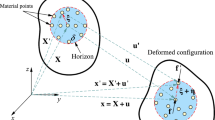Abstract
Intersonic crack propagation is found to exhibit essentially the same features in orthotropic and isotropic materials, provided that the crack propagates along a plane of elastic symmetry. Thus the stress and strain singularity at the crack edge is weaker than the inverse square root singularity in the sub-Rayleigh case, except at one distinct velocity. The energy flux into the process region is determined by using the Barenblatt model. It depends on the crack velocity and on the size of the process region, approaching zero with this size.
Similar content being viewed by others
References
Barenblatt, G.I. (1959a). Concerning equilibrium cracks forming during brittle fracture. The instability of isolated cracks, relationship with energetic theories. Journal of Applied Mathematics and Mechanics 23, 1273-1282. English translation from PMM 23.
Barenblatt, G.I. (1959b). The formation of equilibrium cracks during brittle fracture. General ideas and hypotheses. Axially-symmetric cracks. Journal of Applied Mathematics and Mechanics 23, 622-636. English translation from PMM 23, 434–444.
Barenblatt, G.I., Salganik, R.L. and Cherepanov, G.P. (1962). On the nonsteady motion of cracks. Journal of Applied Mathematics and Mechanics 26, 469-477. English translation from PMM 26, 328–334.
Broberg, K.B. (1980). Velocity Peculiarities at Slip Propagation. Report from the Division of Engineering, Brown University, Providence, R.I.
Broberg, K.B. (1994). Intersonic bilateral slip. Geophysical Journal International 119, 706-714.
Broberg, K.B. (1995). Intersonic mode II crack expansion. Archives of Mechanics 47, 859-871.
Broberg, K.B. (1964). On the speed of a brittle crack. Journal of Applied Mechanics 31, 546-547.
Broberg, K.B. (1967). Discussion of fracture from an energy point of view. Recent Progress in Applied Mechanics (Edited by B. Broberg, J. Hult and F. Niordson), Almqvist and Wiksell, Stockholm, 125-151.
Broberg, K.B. (1989). The near-tip field at high crack velocities. International Journal of Fracture 39, 1-13.
Burridge, R., Conn, G. and Freund, L.B. (1979). The stability of a plane strain shear crack with finite cohesive force running at intersonic speeds. Journal of Geophysical Research 84, 2210-2222.
Freund, L.B. (1979). The mechanics of dynamic shear crack propagation. Journal of Geophysical Research 84, 2199-2209.
Georgiadis, H.G. and Barber, J.R. (1993). On the super-Rayleigh/subseismic elastodynamic indentation problem. Journal of Elasticity 31, 141-161.
Melin, Solveig. (1986). When does a crack grow under mode II conditions? International Journal of Fracture 30, 103-114.
Author information
Authors and Affiliations
Rights and permissions
About this article
Cite this article
Broberg, K. Intersonic Crack Propagation in an Orthotropic Material. International Journal of Fracture 99, 1–11 (1999). https://doi.org/10.1023/A:1018324530191
Issue Date:
DOI: https://doi.org/10.1023/A:1018324530191




